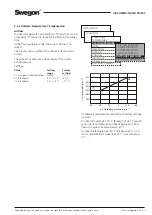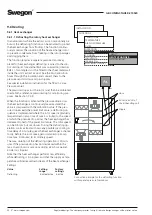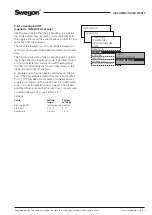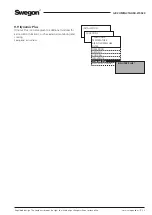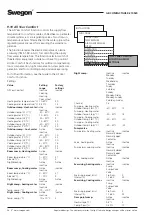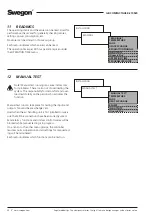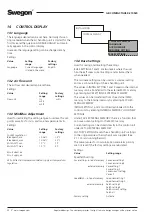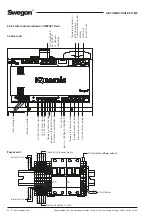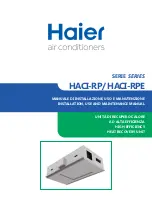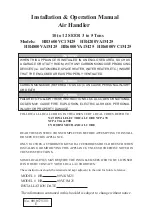
GB.COMPACTAHSK.210520
Registered design. The company reserves the right to make design changes without prior notice.
www.swegon.com 39
Settings:
Value
Setting
Factory
range settings
Time delay
1-600 sec
10 sec
Alarm at closure
1=closure
1
0=disconnection
Alarm reset
0=auto/1=man 0
13.3 Alarm Limits
Changes in the factory-preset alarm limits should only be
made if you have special reasons for doing so and you
should be aware of the consequences.
TEMPERATURE
DEVIATION SA-TEMP (deviating supply air temperature) indicates
how much the supply air temperature is allowed to be below the
supply air temperature setpoint before an alarm is initiated.
MIN EA-TEMP (min extract air temperature) indicates how low the
extract air temperature is allowed to be before alarm is initiated.
FILTERS
SUPPLY AIR/EXTRACT AIR indicates at which level of contamination
in the supply air filter that an alarm will trip.
HEAT EXCHANGER
ALARM LIMIT indicates at which pressure rise an alarm will trip,
if there is an extra installed pressure transducer for the defrosting
function of the heat exchanger.
SERVICE PERIOD
SERVICE PERIOD indicates the period until the next service.
Settings:
Value
Setting
Factory
range settings
TEMPERATURE
Deviating supply air temp.
2-15 °C
5 °C
Min extract air temp.
8-20 °C
15 °C
FILTERS
Supply air
50-300 Pa/
100 Pa/
5-20%* 10%*
Extract air
50-300 Pa/
100 Pa/
5-20%* 10%*
HEAT EXCHANGER
Alarm limit
30-100
Pa 50 Pa
SERVICE PERIOD
Alarm limit
0-99 months
12 months
*Depending on the choice of monitor function.
13.4 Alarm Priority
There should be special reasons for alteration of alarm prior-
ity and you should be aware of the consequences.
Changes in priority should only be made if you have special
reasons for doing so and you should be aware of the conse-
quences. The priority of certain alarms cannot be changed.
Settings:
See 18.2 Alarm Descriptions.
13 ALARM SETTINGS
13.1 Fire Alarms
EXTERNAL FIRE ALARM
Input Inp. 1 or Inp. Can be used for external fire-control
equipment.
Manual or automatic resetting of alarms can be
selected.
INTERNAL FIRE ALARM
The air handling unit’s internal temperature sensors serve as fire
protection thermostats. An alarm is initiated if the supply air tem-
perature sensor registers more than 70 °C or when the extract air
temperature sensor registers more than 50 °C.
If an external Extract air/Room temperature sensor is connected and
activated, this works parallel with the extract air temperature sensor
of the unit.
FANS IN THE EVENT OF A FIRE
The fans in the air handling unit can be used for evacuating gases,
etc. The activated function works together with the External fire/
smoke function or Internal fire alarm.
If the air handling unit is idle, the pre-selected fans will start
up regardless of whether External Stop or Manual Stop has
been activated in the control display.
.
The damper relay in the air handling unit is energized and the
operating relay drops.
The dampers pre-selected for service in the event of a fire, should
be wired to the damper relay and these dampers will open.
The dampers that are meant to close in the event of a fire, should
be wired to the in-operation relay (control unit terminals 19-21) and
these dampers will close.
FAN SPEED IN THE EVENT OF FIRE
Will be activated automatically if the fans have been activated in
event of fire (see above), and make it possible to restrict the max
speed of the fans.
Settings:
Value
Setting range
Factory setting
Internal fire alarm
0=inactive
1=activated
0
External fire alarm
auto/manual
manual
Fan in event of fire
Inactive/EA/SA/
SA+EA
Inactive
Fan speed in event of
fire, SA
10-100%
100%
Fan speed in event of
fire, EA
10-100%
100%
13.2 External Alarms
EXTERNAL ALARMS 1 and 2
The Inp. 1 and Inp. 2 inputs can be used for external alarms (can
be selected under Inputs/Outputs).
Typical uses:
– Motor protection for the circulation pump in the heating or cool-
ing circuit.
– Service alarm actuated by smoke detectors.
Set the time delay and set whether the alarm shall be activated on
closure or disconnection of the input.
INSTALLATION
ALARM SET
*ALARM SETTINGS*
FIRE ALARM
EXTERNAL ALARMS
ALARM LIMITS
ALARM PRIORITY



